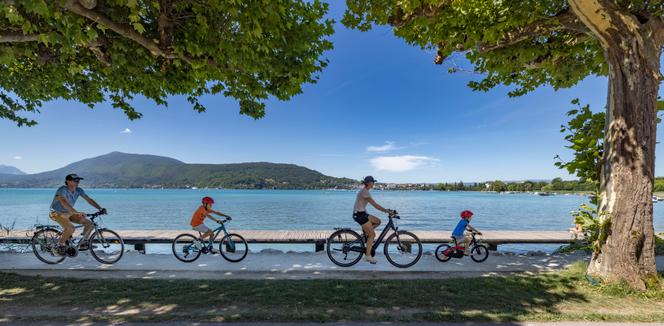


From his bar, he watches them go by: Honed athletes, frantic teenagers, retirees going for it. Parents, too, towing carts from which emerge little helmeted faces. "Now that it's possible to ride around the lake, it's developed at breakneck speed. There are people all the time," explained Pierre, a waiter at the Société des Régates à Voile d'Annecy. "Open-air cafés have set up all along the shore," he said. "Some locals also offer drinks to cyclists."
With day tours, multi-day itineraries and long-distance trips, cycling tourism is booming in France, the world's second most popular destination behind Germany, clocking in over 9 million cycling holidays per year. By 2022, 22 million French people had taken to two wheeled-vacations. "Local authorities invested €500 million in 2019 to promote this sector," stated Véronique Brizon, managing director of ADN Tourisme, the national federation of institutional tourism organizations.
By March, France had completed 79.5% of the network planned in its national cycle route scheme – which aims to complete 26,115 kilometers by 2030 – and almost 95% of the Eurovéloroutes that cross it. "In 2022, average ridership on these European routes increased by 11% in France compared with 2021," continued Brizon, citing the example of the Vélodyssée (its French name), which links Norway to Portugal via France, from Roscoff (Finistère) to Hendaye (Pyrénées-Atlantiques), on the Spanish border.
To support the movement, a three-year "Accueil vélo" ("bikes welcome") certification has been rolled out throughout the region. Today, 6,400 service providers have earned the credential. They include tourism offices, hotels, campsites, river ports, and even railway stations, all of which are committed to providing services for cyclists. These include a bike parking space, a respectable breakfast, route information, and repair tools.
Beside another crystal-clear lake, Lac du Bourget, in the small port of Aix-les-Bains, Compagnie des Bateaux has also earned the green designation. "Before, we only did repairs, but now we’ve upgraded," explained Cécile Revol, head of reception. On the water, one of the shuttles has been redesigned to accommodate around 30 bikes. "Some families come from Chambéry, we take them to Conjux, then they return in the evening by boat," she explained, pointing out that bike transport is free of charge.
After crossing to Hautecombe, the road climbs, then zigzags, with views across the lake to Chanaz. In this pretty village on the banks of the Savières canal, the proximity of the ViaRhôna – which winds its way from Lake Geneva to the Mediterranean – has encouraged the emergence of accommodation for cyclists. At the campsite, a few safari tents are reserved for them. "Here, the advantage is that you can stay for just one night," said David Lopes, a traveler enjoying the fresh air under the awning, his bike beside him. The campsite is recording a growing number of short stays when a minimum five-night reservation is typically required in July and August.
You have 52.94% of this article left to read. The rest is for subscribers only.
